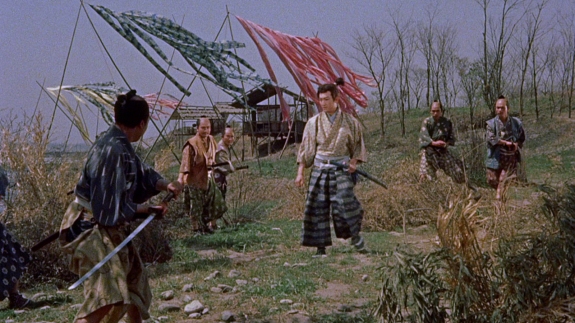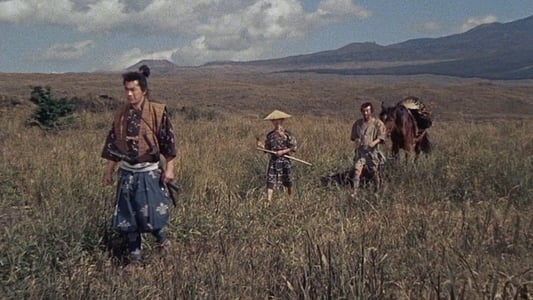Since the first time I watched Throne of Blood (1957) I have been a huge fan of the legendary Japanese actor Toshiro Mifune (1920-1997), particularly his work in jidaigeki or “period dramas.” For the past several years I’ve been working on viewing as many of these films as possible and from the start I knew this would have to include The Samurai Trilogy, a trio of films that dramatize notable incidents in the life of Miyamoto Musashi (1584-1645), arguably the greatest swordsman to ever live. I received the set as a present last year for my birthday, but due to real-life circumstances, I wasn’t able to finish it until last night.
Each film focuses on a major event (or major series of events) in the swordsman’s life:
-In Samurai I, Musashi is a young man named Takezo who dreams of finding wealth and glory far away from the humble village he lives in. His best friend Matahachi also shares dreams of glory and is engaged to Otsu. After being caught on the wrong side of the battle of Sekigahara (which led to the formation of the Tokugawa Shogunate which ruled Japan for nearly 300 years), Takezo and Matahachi are branded outlaws and go on the run. While Matahachi is lured away to Kyoto by a widow and her daughter, Takezo runs wild through the countryside until Takuan, a Buddhist priest, lures him to Himeji Castle (on the premise that Otsu, who has developed feelings for Takezo, is imprisoned there). It’s a trap (of sorts): Takezo is locked into a room inside the castle that is full of books and told he will not be let out until he has bettered himself. Three years later Takezo is released and given the samurai name of Miyamoto Musashi.

Though the film is just over 90 minutes in length, it’s paced in such a way that it feels much longer (such was my impression). Mifune is a delight to watch, as always, and his transformation from the wild Takezo to the stoic Musashi is so extreme you’d almost swear they were played by two different people.
-In Samurai II, the story revolves around Musashi’s conflict with the Yoshioka school, as well as his struggle to fully realize what it means to be a samurai. Initially, Musashi believes that one only needs to be proficient with a sword (which he is), but again and again he is chided for lacking chivalry, compassion and affection. Without these, Musashi is merely a killer, not a samurai. During his journey, Musashi gains his first disciple, an orphan boy named Jotaro. Otsu is still in love with Musashi, but she’s not alone: Akemi, the daughter of the widow from the first film also fancies herself in love with the samurai, though at the moment Musashi himself claims to have chosen “the way of the sword” over the love of any woman. This film also introduces Sasaki Kojiro, another talented swordsman who seeks to build a name for himself by dueling and defeating only the best. He wields a massive longsword nicknamed “Drying Pole.” He badly wants to duel Musashi, but is willing to wait until the samurai has honed his talents further.

I definitely liked this film more than Samurai I. Musashi’s conflict with the Yoshioka school was interesting, considering the students kept stopping the head of the school from meeting Musashi in a fair one-on-one duel. My favorite moments were whenever Musashi faced off with an opponent (or many opponents), sword at the ready. His movements are so precise and artful that I wish there were more moments like this. Koji Tsuruta (1924-1987), who played Sasaki Kojiro, was also a joy to watch. His performance is such that you’re never quite sure what the character is actually thinking.

-The story concludes with Samurai III and recounts Musashi’s famous duel with Sasaki Kojiro at Ganryu Island. At the start of this film, Kojiro is frustrated that, despite all his talent, he is still a ronin (a samurai with no master). To remedy this, he applies to become the teacher of Lord Hosokawa, a position that Musashi is also being recruited for. The two swordsman nearly duel one night, but under pressure to accept the offer to become Hosokawa’s teacher, Musashi leaves town and postpones the duel for one year. As a result, Kojiro receives the position and finally receives the status and luxuries that he has always believed to be his due. Finally the duel is set to be held on Ganryu Island. The pair face off on the beach and for a time seem to be equally matched. But then, in a move so quick I honestly can’t describe it, Musashi strikes the fatal blow and Kojiro falls dead. But Musashi takes no joy in the victory.
Maybe I just wasn’t paying attention, or maybe it took a really long time for Musashi to get to the island, but I could’ve sworn the duel took place at sunset. But apparently it was sunrise because the sun kept getting higher in the sky as things went on (cause otherwise it’s a massive continuity error). I found myself pitying Kojiro as the story went on. It is made clear that this duel does not have to happen. Had he said so, Musashi would have happily continued living his life and Kojiro could have spent the rest of his days as an honored teacher and samurai. Kojiro’s downfall comes from wanting to be the very best swordsman in Japan, nothing else will do. One character summed it up perfectly when he observed “This man’s ambitions are too great.”
In conclusion, I greatly enjoyed The Samurai Trilogy, it is a must-see for anyone wishing to learn more about the great samurai films. If you’ve seen this trilogy, let me know what you thought about it in the comments below and have a great day!
See also:
My Thoughts on Throne of Blood (1957)
My thoughts on: Yojimbo (1961)
You can become a patron of the blog at patreon.com/musicgamer460
Check out the YouTube channel (and consider hitting the subscribe button)
Don’t forget to like Film Music Central on Facebook 🙂



I love Mifune!
LikeLiked by 1 person
He was an amazing actor 🙂
LikeLiked by 1 person